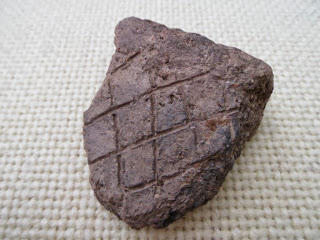A day at the zoo - or at least that was how it felt sometimes with so many people visiting the site and looking down at the burials while we excavated them.
We had our first visits from school groups - the P5 class from
Fountain Primary School who took a short walk from their classroom to visit the site and a group of
secondary school children all the way from
Normandy accompanied by retired St Colman's history teacher, Tom Costigan. Emily also did interviews on Radio Foyle's lunchtime news and a piece went out on BBC Radio Ulster on the 3 o'clock news both of which seemed to draw in the crowds.
Kieron Tourish and the
BBC were back in the afternoon with another short piece featuring on
BBC Newsline (at approx. 15mins; there is also a link on
BBC NW website though I am not sure where they got 'the feet bones that are quite small' quote..). We were also visited by the
Derry Journal, Derry News and
Derry Daily, and by the city's
Lord Mayor Martin Reilly and SDLP's Mark Durcan.
As for the archaeology: we completed the excavation and recording of the seven skeletons we have so far revealed and started to lift five of them (with the juvenile excavated on Monday, this will bring it to a total of six). Two of the adults uncovered at the eastern side of the trench we will leave
in situ and re-bury when we backfill the trench. We have identified the grave cuts of five more burials: we will record the outline of these, some of which run into the baulk (i.e. beyond the edges of the trench), but we will not investigate them any further.
One of the skeletons has a prominent groove in his/her upper incisors from clenching a pipe - clearly
an avid smoker! The same skeleton also displayed a green staining on its cervical vertebrae indicating the presence of copper-alloy pins probably from a shroud long since decayed and rotted away.
The pipe smoker
We also made a couple of interesting finds - the grave fill of one of the skeletons yielded a
lead strap with a stamped 'A' at one end (function - ?) and a possible
stone gaming piece. Malcolm (volunteer) also found a
metal clasp possibly from a leather belt and Margaret (volunteer) discovered the tip of a
copper-alloy pin whilst sieving which appears to have been made from a rolled sheet of metal.
The lead strap with stamped 'A'
With the skeletons excavated we can now start to excavate deeper and hopefully discover earlier features... More next week.
.JPG)

.JPG)
.JPG)
.JPG)
.JPG)
.JPG)


.JPG)

.JPG)

.JPG)
.JPG)
.JPG)


.JPG)
.JPG)
.JPG)
.JPG)

.JPG)
.JPG)


.JPG)

.JPG)
.JPG)
.JPG)


.JPG)
.JPG)
.JPG)


.JPG)
.JPG)


.JPG)
.JPG)
.JPG)
.JPG)
.JPG)
.JPG)
.JPG)
.JPG)